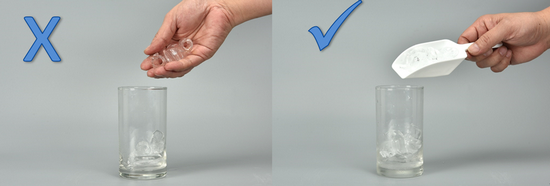
Food Safety Focus (133rd Issue, August 2017 ) – Incident in Focus
Edible Ice Contaminated with Coliform Bacteria
Reported by Dr. Fiona FONG, Research Officer,
Risk Assessment Section,
Centre for Food Safety
Edible ice is widely used in preparing food, e.g. cold drinks. This makes its hygienic quality and safety so important. If not manufactured or handled properly, edible ice can potentially be a vehicle of spreading foodborne diseases.
In July 2017, an edible ice sample collected under the routine Food Surveillance Programme of the Centre for Food Safety (CFS) was found to contain excessive coliform bacteria. This article discusses the potential sources of microbiological contamination in edible ice and preventive measures to minimise the associated risks.
Sources of Edible Ice in Food Premises
Generally speaking, edible ice used for human consumption in retail outlets is from two major sources: (1) supplied by ice manufacturing plants in which the ice is prepared and packed and then transported to the food premises as a packaged form; and (2) produced locally at individual food premises, e.g. by ice-making machines.
Potential Microbiological Contamination of Edible Ice
Source water directly affects the quality and safety of the edible ice manufactured. Generally speaking, provision of public mains water is a standard licensing requirement which provides some form of guarantee of the microbiological quality of source water. After manufacturing, potential sources of microbiological contamination of edible ice include lapses in hygiene in handling of edible ice at the manufacturing plants, during transport and at food premises. During transportation or storage of the packaged edible ice, the external surface of the ice bags can be contaminated with microorganisms which can subsequently cross-contaminate the edible ice during opening and emptying of the ice bags. Poor maintenance of ice-making machine, infrequent cleansing of equipment such as ice buckets and scoops, and unhygienic practices in handling edible ice, e.g. with bare hands, etc., are potential sources of microbiological contamination.

Do not dispense edible ice with bare hands but clean utensils.
Preventive Measures
Potable water supply and good hygiene practices are prerequisites to the production of good quality edible ice. The external surface of the ice bags should be cleaned and dried with a clean cloth before opening and emptying and the external surface of the ice bags and bare hands should not touch the edible ice when filling the ice buckets. Clean utensils such as scoops, instead of bare hands, should always be used to dispense edible ice and the scoops should be cleaned at the end of every working day and whenever necessary (see Figure). Edible ice storage chests should never be used for cooling or storing other items such as cans/bottles of beverages.
As regards the edible ice produced on the food premises by ice-making machines, the machines should be regularly cleaned and properly maintained in accordance with manufacturer’s instructions.
Microbiological Criteria for Edible Ice
Microbiological criteria for edible ice are set out in the Microbiological Guidelines for Food prepared by the CFS. Apart from specific foodborne pathogens, criteria for aerobic colony count (ACC), Escherichia coli (E. coli) and coliform bacteria specifically for edible ice are included. ACC is an indicator of quality while E. coli is a faecal indicator organism which generally indicates direct or indirect faecal contamination. For coliform bacteria, high counts of which generally indicate unsanitary conditions or poor hygienic practices during or after production.
Actions Taken
The CFS has informed the food premises concerned of the irregularity and instructed it to stop selling cold drinks with ice cubes. The CFS has also provided health education on food safety and hygiene to the person-in-charge and staff concerned, and has advised them to carry out thorough cleaning and disinfection of the premises.
Key Points to Note:
- Hygienic quality and safety of edible ice are important as it can potentially be a vehicle of spreading foodborne diseases.
- High coliform count in edible ice is an indication of unsanitary conditions or poor hygiene practices during or after production.
- When handling edible ice, good hygienic practices should be observed so as to minimise the associated microbiological risk.
Advice to the Trade
- Obtain relevant licence from the Food and Environmental Hygiene Department for manufacturing of edible ice.
- If edible ice is produced on premises using ice-making machines, manufacturer’s instructions should be followed for proper cleaning and maintenance of the machines.
- Observe good hygienic practices when handling edible ice.
Advice to the Public
- Use potable water to prepare edible ice.
- Use clean utensils to prepare and store edible ice.
- Avoid any cross-contamination during storage and handling edible ice.

